Transcutaneous Electrical Nerve Stimulation (TENS) is the therapeutic application of electric current through the skin to stimulate nerves. TENS is an electrotherapeutic modality that helps with pain control. It has been used for acute and chronic pain conditions. TENS units administer pulsed electrical stimulation to the skin’s surface using electrodes. These electrical stimulations can be modified in terms of frequency, intensity, and duration. The biggest benefit of using TENS for its analgesic effect is that it is a non-invasive modality. Is a TENS machine good for frozen shoulderA condition where shoulder movement becomes very limited and painful. The cause is often unknown, bu More? In this article we explore what a TENS machine is an how it can help alleviate frozen shoulder symptoms.
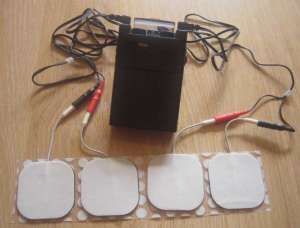
What is a TENS machine?
TENS functions with the application of a pulsed rectangular wave current via surface electrodes placed on the selected area of the skin. This current is often generated by small battery-operated machines in which circuits modify the battery’s output such that it will have a stimulatory effect on the nerves.
Usually, TENS is administered using either high- or low-frequency modes. Although many researchers employ frequencies at or above 100 Hz, high frequency can be defined as being larger than 50 Hz.
Intensity is believed to be important in maximising the effectiveness of the TENS. It should be enough to generate a strong but painless sensation and must be adjusted accordingly throughout the course of the treatment.
What does the TENs machine do?
The TENS machine works by the ‘Gate Control Theory of Pain.’ According to this theory, there exists a ‘gating’ mechanism in the spinal cord that regulates the amount of incoming painful stimuli. The pain stimuli come in through nerve fibres that have a small diameter. The sensory input of the TENS machine comes in via nerve fibres that have large diameters. Hence, it is thought that the larger nerves can block the sensations coming through the smaller ones; thereby, ‘closing the gate for pain’ and its perception.
This may sound confusing, but humans use this mechanism to block pain unknowingly all the time. For example, rubbing your skin after hitting the edge of a table activates the large diameter nerve carrying the sensation of touch to block out the smaller pain-carrying nerve fibres. Thus, similarly, TENS electrically rubs pain away.
How does a TENS machine work?
The TENS machine can be used in the conventional mode or the acupuncture mode. During conventional TENS, low-intensity pulsed currents are administered at higher frequencies at the site of pain. This type of TENS activates large diameter non-noxious afferents (nerves with the incoming stimuli) and blocks the pain. It is more commonly used for acute episodes of pain.
The acupuncture type of TENS is less frequently used. At the site of pain, high-intensity currents are applied at lower frequencies. This is more often used in chronic cases of shoulder painShoulder pain is any pain felt around in and around the shoulder joint. The shoulder is the most mob More.
Now you may wonder if the ‘current’ given out by the TENS machine is anything remotely mimicking an actual electrical current that you get when you accidentally touch a wire. Well, it absolutely isn’t. The current experienced with this machine usually is a mild tingling sensation if you use conventional TENS. It can be slightly irritating in the beginning if you use acupuncture TENS as its main mechanism of action is irritation which counters the pain (counter-irritant effect). However, this does subside and does not cause prolonged discomfort.
Where to place the TENS machine pads for frozen shoulder
Before we answer the ‘where’, let’s focus on the how. How does one apply the electrodes of the TENS machine?
The first thing to do before using the machine is to test it and make sure that the machine along with its wires is intact. You can also test the current via the electrodes on the palm of your hand as a precautionary measure.
Before you do place the electrodes, ensure that you clean the skin over which you will be placing the electrodes.
Ideally, conductive rubber electrodes should be used with conductive gel to gain good skin contact. The electrodes can also be bandaged onto the skin or fixed with adhesive tape.
The electrodes should be placed over the area of pain. If it is a localised pin-point pain, both the electrodes can be placed adjacent to the area of pain. The rubber electrodes are quite malleable, so even if the rounded contour of the shoulder has pain, they can be comfortable stuck over it.
If the pain is a tingling type of pain, the electrodes can be placed in a straight line along the route of the nerve that causes the tingling.
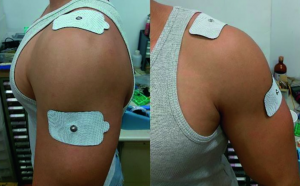
How to use a TENS machine for frozen shoulder
There is some evidence to suggest that TENS may be helpful for frozen shoulder. In one study, TENS was found to be more effective than placebo for reducing pain and improving range of motion in people with a frozen shoulder.
Once the electrodes are stuck, the intensity must be very gradually increased. Higher intensity does not equate to better or faster healing. Thus, in order to avoid any electrical burns, optimal intensity should be chosen. After a while, you may feel that you are getting adapted to the pre-set intensity and the sensation of the machine has reduced, that is when you can gradually increase it.
There is no fixed duration for the application of the TENS machine but usually, about 20 to 25 minutes does suffice to induce pain relief. Using the TENS machine 3 times a week for around 4-5 weeks usually helps with shoulder pain. This may vary from patient to patient as all people have varied symptoms of frozen shoulder. Unlike pain-relief medications, the main advantage of a TENS machine is that it can be used multiple times a day depending on the intensity and severity of pain.
Patients with a frozen shoulder have adhesions in their shoulder jointThe glenohumeral joint is a ball-and-socket synovial joint and is the most mobile joint in the human More capsule and muscular guarding due to pain. Muscular guarding is when muscles contract reflexively as a protective response to pain but remain in a contracted state, which increases the pain.
Thus, they present with pain and a reduced range of movement of the affected shoulder joint. The TENS machine as mentioned does take care of the pain, thereby allowing the patient to move the joint more comfortably.
Additionally, research has shown that the TENS machine can also reduce muscle hardness, thereby inducing flexibility in the muscle tissue. Therefore, after using a TENS machine, it would be beneficial to stretch the affected shoulder joint. However, this should be done gently and within the limits of pain.
Will a TENS Machine help a frozen shoulder?
A TENS machine can provide short term and long term relief for frozen shoulder. If you are suffering from acute pain, which is typical in the freezing stage, a TENS machine electrically rubs the pain away. In the medium to long term, the TENS machine stimulates the muscles, helping to retain strength. This strength is needed as your shoulder range of motion returns.
Measure yourself
Download our app Reflex:Shoulder Mobility App to measure your range of motion and track pain over time. Reflex allows you to visualise your recovery by accurately measuring range of motion and tracking pain levels. 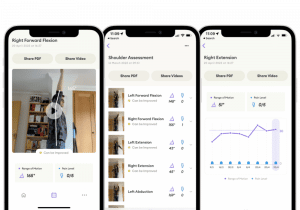
Treatment will vary depending on what stage of frozen shoulder you are in. Your TENS machine can help you in all three stages of frozen shoulder. Below is an example of what your shoulder range of motion looks like in the Thawing Stage of frozen shoulder.
Click here to start plotting your frozen shoulder chart with Reflex
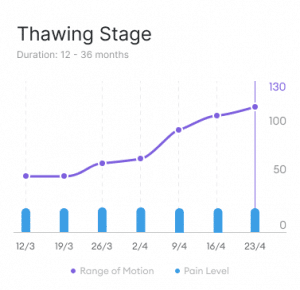
Best TENS Machines for Frozen Shoulder
The Best TENS machine for frozen shoulder may different for everyone. Based on budgets and availability, here are our top picks for the best TENS machine for you if you have symptoms of adhesive capsulitis.
HealthmateForever YK15AB TENS unit
Transcutaneous Electrical Nerve Stimulation unit with dedicated “Shoulder” Mode accessible by its own button
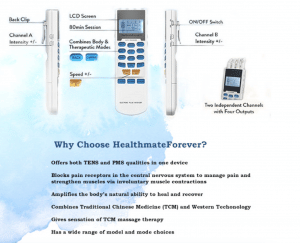
iReliev TENS + EMS Combination Unit
14 Modes including pain relief and muscle strengthening. Good all-rounder for different stages of frozen shoulder. Electrical Muscle Stimulation (EMS) also known as nueromuscular electrical stimulation (NMES) contract muscles using electric stimulation. EMS has the potential to serve as a strength training and rehab tool as well as offer post-exercise recovery benefits for athletes.
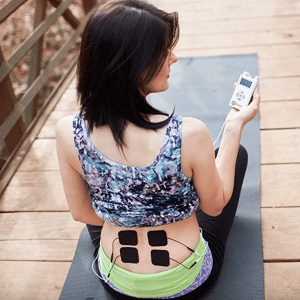
High grade Japanese electrode pads designed for sensitive skin. High quality design, many people upgrade to this model after their entry level devices.
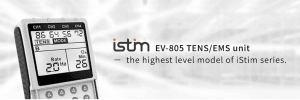
TechCare Massager Touch X – TENS EMS Unit
Powerful and compact
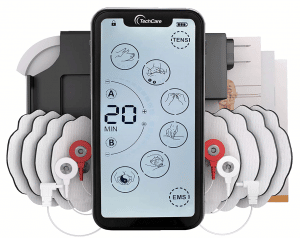
AUVON 4 Outputs TENS Unit EMS Muscle Stimulator Machine
Compact and powerful with a simplistic interface which means changing settings can be tiresome. Each of the 4 outputs connects to 2 pads, so total capacity is 8 pads.

Dangers and precautions of using a TENS Machine for frozen shoulder
- Applying a high intensity of TENS alongside a high frequency for long durations can cause an electrolyte reaction under the electrodes.
- The TENS machine could cause a possible interference with a pacemaker’s functioning if applied too close to it and hence is inadvisable.
- Application of TENS on an area with diminished or altered sensations should be strictly avoided.
